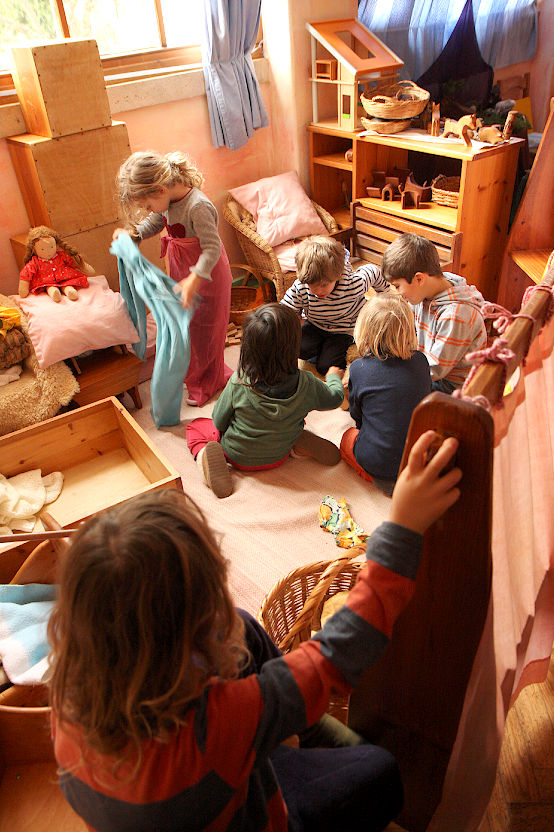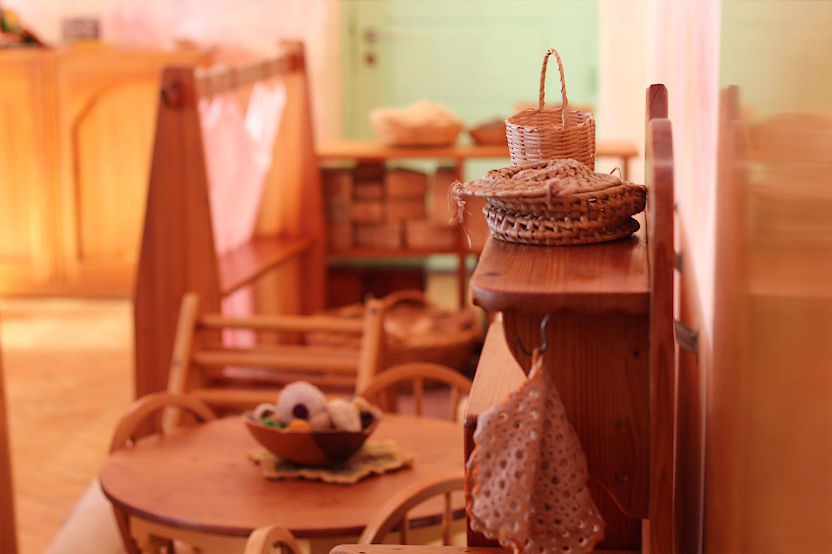Upon entering this Kindergarten one feels the warmth and happiness of being a child. Every nook and corner recognizes the possibility to discover a world beyond what is seen. The care taken for every space both inside and outside the classrooms makes everyone who comes here want to stay and play. And play a lot.
Currently the capacity of the Kindergarten is 44 children between the ages of 3 and 6 years old, and the children are divided into two groups. The capacity of one group is 20 children and the other is 24. Our intention is that each group takes on a life of its own like a family, and that in the heterogeneous group the children create ties and are able to play in a more divers way. Children learn from each other the different ways they can interact between themselves and the world, strengthening their relationships with their peers and with adults. The groups are heterogeneous and organized in a way so that there is a balance of various levels such as the children's’ age, gender, nationality and temperament. This way of organizing mixed aged groups stimulates the older children to help the younger ones and promotes opportunities to perform different tasks. It also gives the younger children the chance to follow an example.

Having space and time to play during their infancy is what we try to provide to the children in our kindergarten. Playing is a creative moment, and it is an very ancient and natural act. According to Schiller a human is only complete when they play and only play when they are completely human. Playing prepares the soil to build new lessons. Playing is the activity par excellence which gives meaning to the organization of the space designated for the children, and the choice of lucid-pedagogical equipment and materials. In this way, we prefer natural and aesthetic materials which highlight sensory parts and thus develop the senses of the child. These materials and toys are simple, intentionally leaving space for the child to develop their own imagination and fantasy. Some of the toys and equipment are made by parents, friends and the educators and workers of the Kindergarten. The cooperative way that toys are built is part of the experience of the Kindergarten.
Space is one of the pillars of learning in Waldorf Pedagogy, and all of the educational environment teaches and transmits something to the child. For this reason the educational environment should be thought of holistically. All of the inside space of the Kindergarten is finished with natural colours and materials. According to Waldorf Pedagogy the child is able to absorb everything that surrounds them. As the child is in the first seven years of life, which is a phase of total absorbance of everything around them, the child should be surrounded by all that is natural and organic.

The Kindergarten is made up of two activity rooms each with their own entrance hall, a multi-use room, two child bathrooms, two adult bathrooms, an office, a kitchen, a pantry and an exterior space. The classroom is painted with natural pigments and colours specific to this age range, allowing the child to be surrounded by the calm and affectionate emotions which the colours transmit.
All of the materials used by the children are natural, made from wood, wool, cloth or iron. The relationship that the child establishes between what they live on their inside and the environment which surrounds them is extremely important for their development. On one hand the child is very aware of what’s on their inside, at the same time the child is totally receptive to what their environment transmits to them, such as forms, colours, and materials. Everything the child experiences in their environment will create defining impressions for the rest of their lives. A child in the first seven years of life is very open to all of the sensory stimulus they receive. For all of these reasons the toys and materials of the classroom are collected from nature (shells, logs, pine cones…) or made with simple natural materials and sometimes left unfinished without too many details. These options allow the child to participate in an active way, giving freedom to each child to create their imagination and internal world.